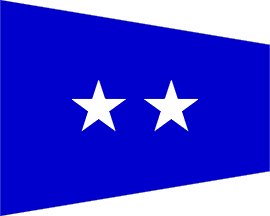 (4:5) image
by Željko Heimer, 22 August 2003
(4:5) image
by Željko Heimer, 22 August 2003
Last modified: 2014-05-22 by zoltán horváth
Keywords: venezuela |
Links: FOTW homepage |
search |
disclaimer and copyright |
write us |
mirrors
See also:
 (4:5) image
by Željko Heimer, 22 August 2003
(4:5) image
by Željko Heimer, 22 August 2003
Capitán de Fragata / Capitán de Fragata / Commander -
According to the Naval Ceremonial and Protocol Regulations number
MAN-EC-CGA-0001-B effective since July 1st, 1997.
Raul Orta, 18 May 2002
According to Album 2000 Corr. 3 [pay03]
- Commander (4:5) - Blue trapezoidal pennant with two white
five-pointed stars horizontally arranged.
Album 95 [pay] described it as
similar to Album 2000, but lighter blue.
Željko Heimer, 22 and 28 August 2003
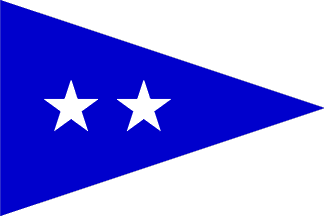 (2:3) image
by Željko Heimer, 22 August 200
(2:3) image
by Željko Heimer, 22 August 200
Teniente de Fragata / Commander (junior grade) - According to
the Naval Ceremonial and Protocol Regulations number
MAN-EC-CGA-0001-B effective since July 1st, 1997.
Raul Orta, 18 May 2002
According to Album 2000 Corr. 3 [pay03]
- Commander not in command (2:3) - Blue triangular pennant with
two white five-pointed stars horizontally arranged.
Željko Heimer, 22 August 2003
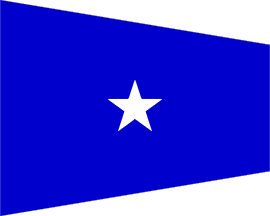 (4:5) image
by Željko Heimer, 22 August 2003
(4:5) image
by Željko Heimer, 22 August 2003
Capitán de Corbeta / Lieutenant Commander - According to the
Naval Ceremonial and Protocol Regulations number
MAN-EC-CGA-0001-B effective since July 1st, 1997.
Raul Orta, 18 May 2002
According to Album 2000 Corr. 3 [pay03]
- Lieutenant Commander (4:5) - Blue trapezoidal pennant with a
white five-pointed star.
Album 95 [pay] described it as
similar to Album 2000, but lighter blue.
Željko Heimer, 22 and 28 August 2003
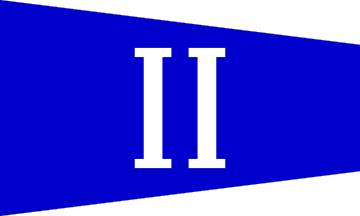 image
by Željko Heimer, 26 August 2003
image
by Željko Heimer, 26 August 2003
There is no such flag at Naval Ceremonial and Protocol
Regulations number MAN-EC-CGA-0001-B effective since July 1st,
1997. The Pennant with the roman number two was sent to the
General Command of the Navy of Venezuela to know its meaning.
Raul Orta, 18 May 2002
In the original Album 2000 [pay00]:
Division Commander (3:5) (number of unit) - Blue trapezoid
pennant with white roman numeral indicating the number of the
division in question, shown here as II.
The 1997 regulations do not have the matching flag - presumably
this one is from some older pattern, the "title" might
have been lost since.
How many divisions the Venezuelan Navy had at most? Where they
all numbered sequential by Roman numbers?
Album 95 [pay] described it as
similar to Album 2000 (with division number), but lighter blue.
Željko Heimer, 26 August 2003
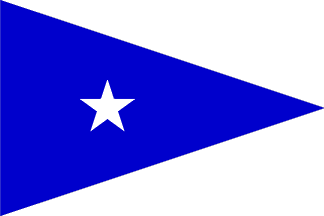 (2:3) image
by Željko Heimer, 22 August 2003
(2:3) image
by Željko Heimer, 22 August 2003
Alférez de Navío/ Lieutenant - According to the Naval
Ceremonial and Protocol Regulations number MAN-EC-CGA-0001-B
effective since July 1st, 1997.
Raul Orta, 18 May 2002
According to Album 2000 Corr. 3 [pay03]
- Lieutenant (2:3) - Blue triangular pennant with a white
five-pointed star.
Following the logic above, this would be Lieutenant Commander not
in command. Anyway is this used for all the junior officers:
Lieutenant, Lieutenant junior Grade and Ensign (Teniente de
navío, Teniente de fragata, alférez).
Željko Heimer, 22 August 2003
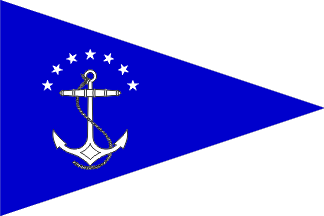 (2:3) image
by Željko Heimer, 22 August 2003
(2:3) image
by Željko Heimer, 22 August 2003
Oficial Superior Presente a Flote / Senior Officer Afloat -
According to the Naval Ceremonial and Protocol Regulations number
MAN-EC-CGA-0001-B effective since July 1st, 1997.
Raul Orta, 18 May 2002
According to Album 2000 Corr. 3 [pay03]
- Senior Officer afloat (2:3) - Blue triangular pennant with
white fouled anchor and seven five-pointed stars in an arch above
it. The previous sources report a flag with simpler anchor. Was
this in use before 1997? When was it adopted? Is it really wrong?
Željko Heimer, 22 August 2003
Flag at Original Album 2000
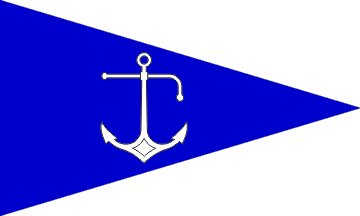 (3:5) image
by Željko Heimer, 26 August 2003
(3:5) image
by Željko Heimer, 26 August 2003
In the original Album 2000 [pay00]:
Senior Officer Afloat (3:5) Triangular blue pennant with white
anchor in the middle. The anchor is of the same "old"
pattern as in the CGN flag (except in
one little details I shall come back at once). here also either
it is an older pattern, or misinterpretation. The Album shows
two slightly different anchors used in the CGN and SOA flags,
notably the later do not include the lozengy ornament in the
lower end of the anchor. I find it unusual that they are not the
same, so I assumed that the SOA figure in Album might have been
missing it inadvertently. Could that be verified?
Album 95 [pay] described it as
similar to Album 2000, but lighter blue.
Željko Heimer, 26 and 28 August 2003

image
by Željko Heimer, 24 August 2003
According to Album 2000 Corr. 3 [pay03]
- Masthead Pennant - Yellow over blue over red long triangular
tapering pennant. Ratio is not given, the image shows it ca.
2:23~ (or 1:11~ if you prefer, which is used throughout the
Album as default ratio for masthead pennant when more precise
data was not available).
In Album 95 [pay], dimensions are
given as 0.21x3 m that is ratio 7:100, or very much like 1:14~.
In the 1939 Flaggenbuch [neu92]:
Masthead pennant - Tricolour pennant but not triangular but
rectangular and swallowtailed (without indication of the total
length and depth of the indentation at fly).
Željko Heimer, 24 and 28 August 2003
Masthead Pennant in 1926 Flaggenbuch

image
by Željko Heimer, 6 September 2003
In the 1926 Flaggenbuch: Masthead pennant - Unlike the latter
pennants, this one is vertically divided in yellow- blue-red. The
length is not clear, as it is indicated much longer by a tear in
the middle of the red part of the image.
by Željko Heimer, 6 September 2003